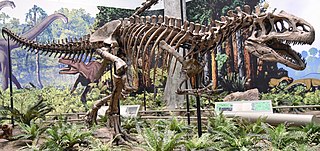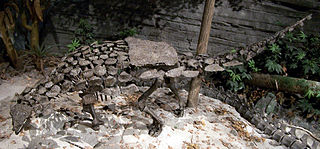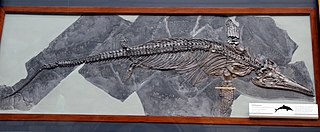
Metatheria is a mammalian clade that includes all mammals more closely related to marsupials than to placentals. First proposed by Thomas Henry Huxley in 1880, it is a more inclusive group than the marsupials; it contains all marsupials as well as many extinct non-marsupial relatives. It is one of two groups placed in the clade Theria alongside Eutheria, which contains the placentals.

Sparassodonta is an extinct order of carnivorous metatherian mammals native to South America, related to modern marsupials. They were once considered to be true marsupials, but are now thought to be a separate side branch that split before the last common ancestor of all modern marsupials. A number of these mammalian predators closely resemble placental predators that evolved separately on other continents, and are cited frequently as examples of convergent evolution. They were first described by Florentino Ameghino, from fossils found in the Santa Cruz beds of Patagonia. Sparassodonts were present throughout South America's long period of "splendid isolation" during the Cenozoic; during this time, they shared the niches for large warm-blooded predators with the flightless terror birds. Previously, it was thought that these mammals died out in the face of competition from "more competitive" placental carnivorans during the Pliocene Great American Interchange, but more recent research has showed that sparassodonts died out long before eutherian carnivores arrived in South America. Sparassodonts have been referred to as borhyaenoids by some authors, but currently the term Borhyaenoidea refers to a restricted subgroup of sparassodonts comprising borhyaenids and their close relatives.

Alphadon is an extinct genus of small, primitive mammal that was a member of the metatherians, a group of mammals that includes modern-day marsupials. Its fossils were first discovered and named by George Gaylord Simpson in 1929.

Allosauridae is a family of medium to large bipedal, carnivorous allosauroid theropod dinosaurs from the Late Jurassic. Allosauridae is a fairly old taxonomic group, having been first named by the American paleontologist Othniel Charles Marsh in 1878. Allosaurids are characterized by an astragalus with a restriction of the ascending process to the lateral part of the bone, a larger medial than lateral condyle, and a horizontal groove across the face of the condyles.

Nodosauridae is a family of ankylosaurian dinosaurs, from the Late Jurassic to the Late Cretaceous period in what is now North America, South America, Europe, and Asia.

Zhejiangosaurus is an extinct genus of ankylosaurian dinosaur from the Upper Cretaceous of Zhejiang, eastern China. It was first named by a group of Chinese authors Lü Junchang, Jin Xingsheng, Sheng Yiming and Li Yihong in 2007 and the type species is Zhejiangosaurus lishuiensis. It has no diagnostic features, and thus is a nomen dubium.

Beelzebufo is a particularly large species of prehistoric frog described in 2008. Common names assigned by the popular media include devil frog, devil toad, and the frog from hell.

Herpetotherium is an extinct genus of metatherian mammal, belonging to the possibly paraphyletic family Herpetotheriidae. Native to North America from the Eocene to Early Miocene, fossils have been found in California, Oregon, Texas, Florida, Montana, Wyoming, Colorado, North and South Dakota, Nebraska, and Saskatchewan. The oldest species, H. knighti, is dated to around 50.3 mya, and the most recent, an unnamed species, may be as recent as 15.97 mya. A morphological analysis of marsupials and basal metatherians conducted in 2007 found Herpetotherium to be the sister group to extant marsupials. It is the youngest known metatherian from North America until the migration of the Virginia opossum from South America within the last 2 million years.

Herpetotheriidae is an extinct family of metatherians, closely related to marsupials. Species of this family are generally reconstructed as terrestrial, and are considered morphologically similar to modern opossums. Fossils of herpetotheriids come from North America, Asia, Europe, Africa, and perhaps South America. The oldest representative is Maastrichtidelphys from the latest Cretaceous (Maastrichtian) of the Netherlands and the youngest member is Amphiperatherium from the Middle Miocene of Europe. The group has been suggested to be paraphyletic, with an analysis of petrosal anatomy finding that North American Herpetotherium was more closely related to marsupials than the European Peratherium and Amphiperatherium.
Bullichthys is an extinct genus of marine albuliform fish which existed in the Romualdo Formation, Brazil during the Early Cretaceous (Albian) period. The type species is B. santanensis. The genus name references its inflated otic bulla.

The Ichthyosauromorpha are an extinct clade of marine reptiles consisting of the Ichthyosauriformes and the Hupehsuchia, living during the Mesozoic.

Siamoperadectes is a genus of non-marsupial metatherian from the Miocene of Thailand. A member of Peradectidae, it is the first member of its clade known from South Asia, and among the last non-marsupial metatherians.

Electrorana is an extinct genus of frog that lived in what is now Myanmar during the mid-Cretaceous, around 99 million years ago. The type and only species is E. limoae. The generic name is derived from the Latin electrum and rana, while the specific epithet is given in honour of Mrs. Mo Li, who purchased and provided the specimens for study.

Unnuakomys is an extinct genus of metatherian mammal from the Maastrichtian age of the Late Cretaceous. It was discovered in the Prince Creek Formation of Alaska, and is the northernmost metatherian known. The type species is U. hutchisoni.

Meiolaniformes is an extinct clade of stem-group turtles, defined as all taxa more closely related to Meiolania than to Cryptodira and Pleurodira. It is known from the Early Cretaceous to the Holocene of Australia, Oceania and South America. Some Eurasian taxa have been suggested to be part of the group, but this is disputed.

Peradectes is an extinct genus of small metatherian mammals known from the latest Cretaceous to Eocene of North and South America and Europe. The first discovered fossil of P. elegans, was one of 15 Peradectes specimens described in 1921 from the Mason pocket fossil beds in Colorado. The monophyly of the genus has been questioned.

Proborhyaena is an extinct genus of proborhyaenid sparassodont that lived during the Oligocene of what is now South America. It is considered to be the largest of the sparassodonts.
Patagopelta is an extinct genus of nodosaurine dinosaur from the Late Cretaceous Allen Formation of Argentina. The genus contains a single species, P. cristata, known from a partial skeleton. Patagopelta is a very small ankylosaur, comparable in size to the dwarf nodosaurid Struthiosaurus, about 2 m (6.6 ft) long.
Ruixinia is an extinct genus of somphospondylan titanosauriform dinosaur from the Early Cretaceous (Barremian) Yixian Formation of China. The genus contains a single species, Ruixinia zhangi. The Ruixinia holotype is a partial articulated skeleton with the most complete series of caudal vertebrae known from any Asian titanosauriform.
Andinodelphys is an extinct genus of non-marsupial stem metatherian.



















